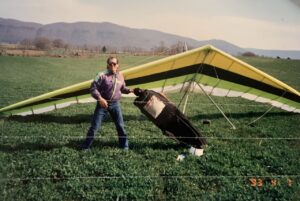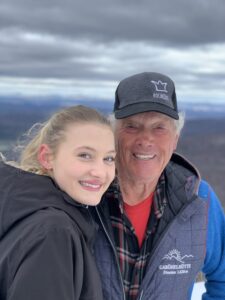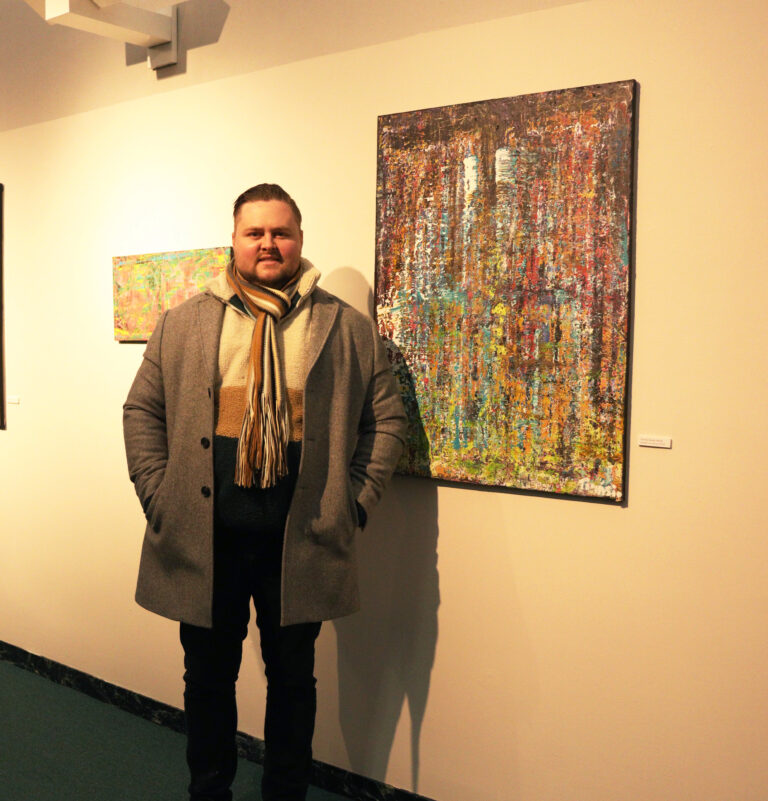Living on the edge: Student shares stories about the life of her adventurous Opa

The blisters covering my feet halted my journey up my grandfather’s mountain in West Rutland. In retrospect, ankle socks were not the best idea. The rest of the family kept going, all nine of them.
I was out of breath, and only 10 minutes on the straight incline toward the top. I was barely 6 years old. I knew it was going to be a long hike.
Without hesitation my grandfather, Opa, hoisted me into the air and plopped me on his shoulders. He continued trucking up as if I was not there. My feet were so relieved. I was like a baby monkey clinging to its mother, both making sure I was not going to be left behind – and enjoying the free ride.
Not much later, my sister and cousins started to chirp. Are we there yet?
Answering all of the children’s thoughts with a thick accent like Arnold Schwarzenegger, he just kept saying “on the next corner.”
Eight more corners passed.
What seemed like forever lasted a short 45 minutes, 30 minutes faster than what it should take a person going at an acceptable pace. I was let down just in time for the bit of downhill walking before the destination: a green mailbox with white letters that read “Jake’s Mailbox.”
Of course I had to open it.
Empty.
No wonder why, what postal carrier could get up that water-bar infested road?
We had been in the trees the whole time, and I was not expecting what was going to be at the top. What was so special about this mountain with the treacherous road up?
I found out when we got to the clearing.
You could see the entire world.
Overlooking the highway the cars looked like little ants finding their way back to their home. You could see Birdseye Mountain, each peak forming the body of a woman lying on the earth. The New York mountains had never seemed so close. But that was not as interesting as what we were heading toward.
At the edge of the mountain was a platform, 20 feet long – heading straight off the side. Who would put this dangerous tar covered floor plateauing off the side of a cliff? A crazy person?
That’s when I learned what hang gliding was.
And it was Opa’s idea to build it here.
I looked over in fear, the sight of the pitch sent my stomach into my throat. I could almost feel myself falling down. Looking back to the madman standing next to me, you could see memories passing through his eyes.
This man really used to jump off the side of this mountain. Is that normal?
That’s when I knew Opa was not like other men, definitely not like other grandfathers.
It is important to note my grandfather is not from America. He grew up in the later years of WWII, which affected his education. Granted there was not much schooling required in his small hometown of Dienten Austria, so most children worked in the farms.
How did he learn to hang glide?
As he grew up, he realized that there was more to the world than his small village so he followed his older brother, my great uncle Sep, to America at the young age of . In the late ‘60s in Vermont there was a surprisingly big hang gliding community where Opa fit the scene.
He worked at Pico Mountain as a ski instructor, met my grandmother, and taught himself how to fly.
With the help of other pioneer glider pilots, Opa learned wind patterns from airplane textbooks. And with a lot of trial and error, and even more guts – he started to soar over the plains of West Rutland, Castleton, and even made it to Burlington on a particularly windy day.
I don’t think anyone could do that.
There must be a screw loose, or trust in his good luck because it’s not just hang gliding that sets Opa’s life apart from the rest by living on the edge. And his luck is better than most.

Examples.
One day coming back from a job site, he did not see a train barreling toward him. On impact the cab of his truck gave like an alumni can, metal shrieking as he was pushed yards down the tracks.
The train stopped.
He got out.
Gathering his composure he walked right up to the conductor and said, “Hallo you just hit me.”
“No I didn’t, that guy is dead,” the conductor affirmed.
The shock sent the conductor into cardiac arrest and he was taken to the hospital in an ambulance.
Let’s continue.
Building his house in Vail, Colorado, where he lives now, a gust of wind caught the plywood and blew him over and he took a 2 story drop.
He crushed the lumbar support in his back between L3 and L4, but managed to drag himself into his room for two days. Nothing rest can’t fix. He was brought to the hospital on the plywood sheet. When he woke up from surgery he was serious when he said, “Can we go skiing now?”
I could tell dozens of more stories, like how he held onto the underside of a truck after they collided with his motorcycle and was dragged for a mile until they stopped at the gas station.
Nothing but a few scratches.
Or the time he fell three times in one day, but kept working, which sparked a brain bleed. He got 80 staples, one for each year he had lived.
He is now 83 and still hikes his mountain in West Rutland when he visits us, most recently a few months ago – and I wore appropriate socks this time. He is a bit slower now, and more red in the face by the time we get to the top. What has not changed is the same look in his eyes when he gets to the top.
Opa does not stop – as a choice – and he appreciates every day he has. Embrace the thrill because as soon as you stop living you start to die. Don’t believe it from me, but believe it from Jakob, my Opa, the man who jumps off mountains.







